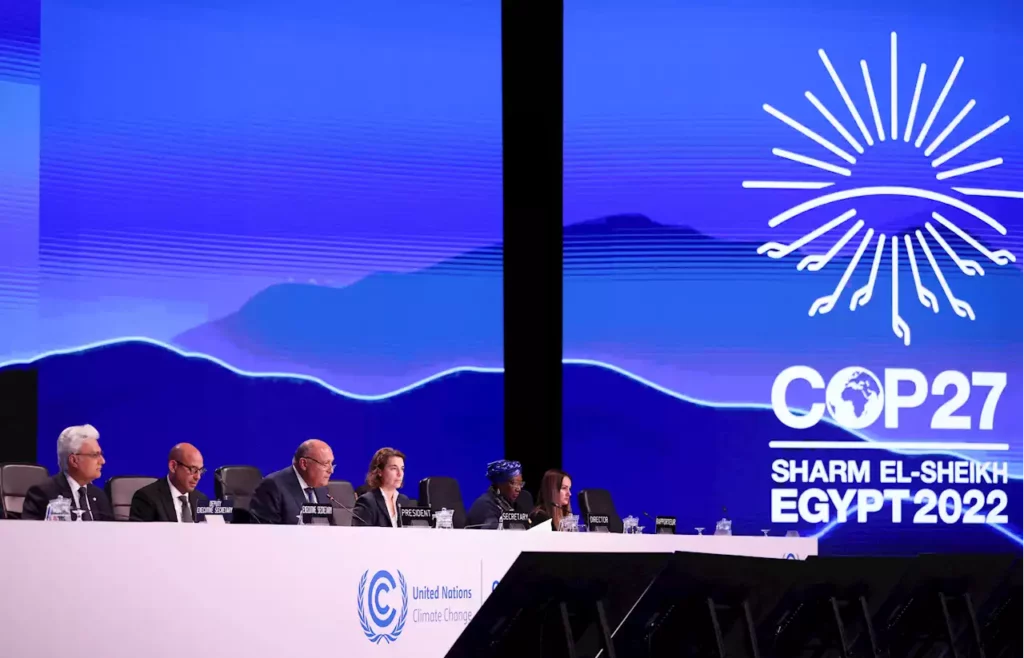With COP27 looming we are once again being treated to the predictable doomfest in which media outlets compete to see who can offer up the scariest headlines as they flit between the perennial themes of COP-is-our-last-chance-to-avoid-Armageddon and COP-is-just-empty-posturing. Even the venerable Chatham House, founded in 1902 and occupying an 18th-century building in which three British Prime Ministers lived including William Pitt, 1st Earl of Chatham, and itself home of the “Chatham House Rule“ and ostensibly a forum for serious thought, got into the spirit of the season, blaring “What is COP27? COP27 will be a critical test of whether the international process can respond to the increasing urgency of climate change.” Sorry old chaps, you’ll have to work on your hysterical tone if you want to match what the pros are coming up with.
For example, NBC’s “Climate In Crisis” section says climate in crisis, as you’d rather expect them to since their paycheque depends on it: “Greenhouse gases in Earth's atmosphere hit record high in 2021/ The U.N. weather agency published the alarming report less than two weeks before world leaders gather for the U.N. Climate Change Conference.
Not to be outdone The Economist says countries are slacking off on climate and disaster looms whether we act or not:
“The world is already experiencing increasingly erratic weather, including stronger storms and more unpredictable and extreme rainfall patterns, leading to deluges in some places and droughts in others. Even if global average temperature increases are stabilised at 1.5°C, that will still get worse.”
NBC tries again in another “Climate in Crisis” piece which shrieks “World ‘nowhere near’ hitting climate targets, U.N. warns/ Latest estimates say temperatures will rise to 4.5 degrees Fahrenheit above pre-industrial averages by the end of the century, the U.N. climate office said in a new report.” For those who are not bilingual, 4.5F is 2.5C (in absolutes; if the thermometer says 4.5F it’s -17.2C). And then everything gets it: “That means the planet is on course for a future marked by unprecedented heat waves, destructive storms and drought, as well as the extinction of animal and plant species.”
Of course they are all pikers compared to the Guardian, which moans “World close to ‘irreversible’ climate breakdown, warn major studies/ Key UN reports published in last two days warn urgent and collective action needed – as oil firms report astronomical profits”. (On which subject, Canada’s government propagandist CBC just ran a headline “Environment minister slams oilpatch for shelling out sky-high profits to shareholders” as if the rational thing for a firm that is making money in the near term but faces a dismal future due to political hostility were not to get the money out while they still have it rather than invest it in losing propositions.)
Though honourable mention goes to the New York Times which thunders “Climate Pledges Are Falling Short, and a Chaotic Future Looks More Like Reality/ With an annual summit next month, the United Nations assessed progress on countries’ past emissions commitments. Severe disruption would be hard to avoid on the current trajectory.”
Say what? Are we doomed? Yeah.
“Without drastic reductions in greenhouse gas emissions, the report said, the planet is on track to warm by an average of 2.1 to 2.9 degrees Celsius, compared with preindustrial levels, by 2100. That’s far higher than the goal of 1.5 degrees Celsius (2.7 degrees Fahrenheit) set by the landmark Paris agreement in 2015, and it crosses the threshold beyond which scientists say the likelihood of catastrophic climate impacts significantly increases.”
Not “some scientists”, mind you. Not even “climate scientists”. Just “scientists”. We know because we didn’t ask them.
As for doomed, we’re sliced, diced and fried. “With each fraction of a degree of warming, tens of millions more people worldwide would be exposed to life-threatening heat waves, food and water scarcity, and coastal flooding while millions more mammals, insects, birds and plants would disappear.” Each fraction? Even if it’s one-fiftieth? Possibly this rising young journalistic star with a BA in international relations dozed off during math class and thought fractions didn’t get smaller than a half. As for millions more mammals disappearing, say it ain’t so. Ok. It ain’t so. Though it’s hard to be sure which class you’d have to sleep through to believe that one.
The home team gets into the game, albeit with muddled messaging, with the Globe & Mail offering “Egypt's resilient coral reefs are under threat” due to “climate change and human activity”. And of course Greta Thunberg, who we recently praised for showing some signs of maturity, goes back to her petulant teenage roots by blasting climate summits including COP27 as a “scam” because “these systems are failing us” unless we “mobilize” but then fudged on whether vandalizing art is good before noting that politicians who make empty promises to thunderous applause are “greenwashing, lying and cheating” which while unkind is not unreasonable.
With this picture of innumerate disaster swirling about, it seems no one much cares, according to the NY Times article. “Wednesday’s report comes less than two weeks before nations are set to gather at U.N. climate talks in Sharm el Sheikh, Egypt, to discuss unfulfilled promises and take stock of the fight to stave off environmental catastrophe.” Sounds bleak, doesn’t it? Especially since as he cements his dictatorial control in China, Xi Jinping makes increasingly little effort to conceal what he really thinks of this whole alternative energy business and the famous ChiCom green-on-a-dime turn that Canadian PM Justin Trudeau so foolishly praised nine years ago.
Notwithstanding an unbroken string of failures the COP gravy train shows no sign of winding down. They are the work of the UN Framework Convention on Climate Change, hence the “Conference of the Parties” or COP, which naturally has its own massive lavish administrative structure in which “Around 450 staff are employed at UN Climate Change. Secretariat staff come from over 100 countries and represent a blend of diverse cultures, gender and professional backgrounds.” And at least seven layers of that bureaucracy bring in six-figure (in Euro) salaries. But for what?
Especially since that bleak Times piece warns that:
“Just 26 of 193 countries that agreed last year to step up their climate actions have followed through with more ambitious plans. The world’s top two polluters, China and the United States, have taken some action but have not pledged more this year, and climate negotiations between the two have been frozen for months. Without drastic reductions in greenhouse gas emissions, the report said, the planet is on track to warm by an average of 2.1 to 2.9 degrees Celsius, compared with preindustrial levels, by 2100. That’s far higher than the goal of 1.5 degrees Celsius (2.7 degrees Fahrenheit) set by the landmark Paris agreement in 2015, and it crosses the threshold beyond which scientists say the likelihood of catastrophic climate impacts significantly increases.”
So yeah, might as well stay home. Though Wikipedia reminds us that “On October 14, 2022, the Scottish government called for climate reparations at COP27, as a ‘moral responsibility’.” Any bets on how much it’s willing to pay, as opposed to how much it’s willing to say?
Mind you the actual amounts on the table are incalculably huge, David Wojick warns on CFACT, since all bad things are the result of climate change. Or rather, the actual amounts not on the table since this one is never going to happen, a point people who are chronologically adults should readily grasp but appear not to.
So yeah, it was all just talk.



It's not all gloom and doom; it's just gloom.
Considering the aim is to reduce global temperatures to pre-industrial revolution levels and that the Little Ice Age ended in 1850, we have 450 years of cold. Now the Little Ice Age many not have been global but it would have an effect on the global average. Global average is finekity any depending on the data you imput... eg there were few termometers in the Souther hemisphere pre 1930. But from the low point of the Little Ice Age, which way would the temperature be expected to go?